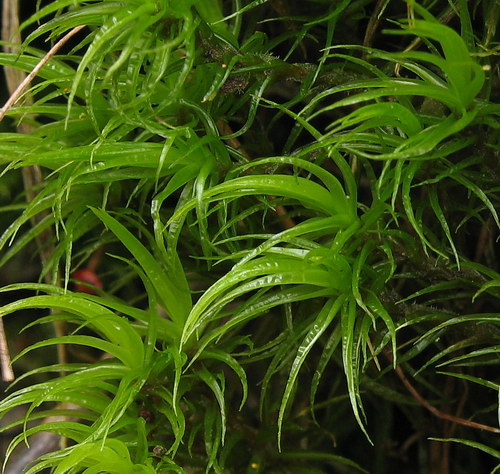
(If you need to know what a pleurocarp is, click here)
B. Other or unknown — 1
1 Stems red; robust, rigid, irregularly pinnately branched; abundant in upland woods and on hillsides in wetter districts of north and west — Rhytidiadelphus loreus
Stems green or blackish; habitats various — 2
2 On trees — Hypnum cupressiforme
Some other habitat — 3
3 Terrestrial: on banks, wall-tops, stony ground, etc. — 4
Semi-aquatic: in marshes or bogs, or on wet rocks by streams and lakes —7
4 Shoots tending to be flattened in one plane, up to 4-5 mm. wide; leaves often transversely wrinkled; plant of calcareous rocks — Neckera crispa (falcate forms)
Shoots not tending to be flattened in one plane, not above 2 mm. wide — 5
5 Plant with numerous nearly erect shoots, themselves sparingly branched; glossy, light yellowish green plant of grassy banks, etc., chiefly on acid soils — Brachythecium albicans (Brachythecium key)
Shoots mainly prostrate or nearly so, with numerous pinnate branches — 6
6 Branches very crowded; shoot tips notably pale green, their ends strongly curled in various directions; abundant in calcareous habitats — Ctenidium molluscum
Branches not crowded; all leaves regularly curved and turned downwards (but not strongly curled as above); abundant, wide- spread, very variable species — Hypnum cupressiforme
7 On rocks, by lakes, streams or waterfalls — 8
On peaty or other soil, in marshes, bogs or pools —13
8 Plant dark red-brown, purple-brown or blackish green; primary stem prostrate with long (8-15 cm.), little branched, nearly prostrate secondary shoots — Scorpidium scorpioides
Plant yellowish green to golden; secondary shoots either short, erect and nearly simple or long and freely branched —9
9 Primary stem prostrate with few or many short, nearly simple erect or ascending secondary shoots — 10
Secondary shoots long and freely branched, often regularly pinnate — 11
10 Shoots bright glossy green, tinged golden brown; leaves crowded; leaf apex acute — Brachythecium plumosum (Brachythecium key)
Shoots dull yellowish green to brownish; leaves not crowded, lower parts of stems often quite bare of leaves; leaf apex blunt — Hygrohypnum palustre
11 Older stems much interwoven with red-brown tomentum (rhizoids); leaves uniformly and strongly curved; nerve present — Cratoneuron commutatum (Cf. also C. filicinum, which has shorter, much less strongly curved leaves.)
Red-brown tomentum lacking; leaves more strongly curved at shoot tips than elsewhere; nerve absent —12
12 Young shoots very small and crowded, their leaves strongly curled; on calcareous rocks — Ctenidium molluscum
Young shoots not crowded, often elongated, their leaves only lightly curved; mainly on siliceous rocks by waterfalls, etc. — Hyocomium armoricum
13 Leaves only about 1 mm. long; on wet ground in lime-rich marshes and fens — 14
Leaves longer (2-4 mm.); habitat various, but rarely as above — 15
14 Young shoots very small and crowded, their leaves strongly curled; nerve absent — Ctenidium molluscum
Young shoots not crowded, nerve present — Cratoneuron filicinum
15 Leaves crowded; noticeably broad, concave and shortly pointed at their tips; dark red-brown, purplish or blackish green plant with long, prostrate, little-branched shoots on wet peat — Scorpidium scorpioides
Leaves finely pointed; combination of leaf shape and habitat not as above; habitats various —16
16 Leaves strongly and uniformly curved (almost to form semi-circle); shoots often variegated orange and crimson — Drepanocladus revolvens
Leaves slightly curved, or rather strongly curved only at shoot tips — 17
17 Whole plant glossy yellowish green; leaves not above 2 mm. long; on wet ground — Brachythecium rutabulum (marsh forms) (Barchythecium key)
Plant blackish below, dull or glossy yellowish green or reddish above; leaves 3-4 mm. long; chiefly in pools —18
18 Plant light green or yellowish; leaves often nearly straight, usually rather wide with fairly short fine point — Drepanocladus aduncus
Plant usually dark, often dark olive-green or reddish above and brown or black below; leaves rather strongly curved at shoot tips, very narrow and finely pointed; in acidic (base-poor) waters — D. fluitans or D. exannulatus
(N.B. In some districts, especially in mountain habitats, D. exannulatus is commoner than D .fluitans. The two cannot be separated with certainty except under the microscope.)
If moss does not key out here, try the other pleurocarps key or the Brachythecium key.

 |
For comments about this site please
mail to:
 (e-mail address given as graphic to avoid spam) |